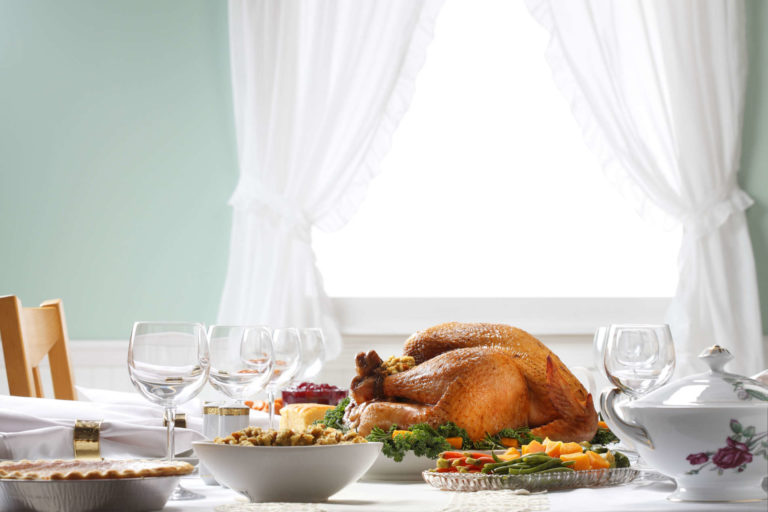Hosting a holiday meal can bring family and friends together for a day of good food and fellowship, but the day can also spell stress for the host or hostess.
There are ways, however, to avoid some of the stress when hosting a holiday meal, according to Karen Blakeslee. “Traditional Thanksgiving menus can be easily divided so guests can share in the preparation and lighten the load for holiday hosts,” says Blakeslee, a Kansas State University Research and Extension food scientist.
Here are a few frequently-asked questions — and her answers — related to preparing a turkey and storing holiday leftovers.
Q 1: How much turkey should I buy?
A: The general rule in buying a bone-in turkey is to allow one pound per person. If additional white meat is preferred, consider buying a larger turkey or an additional turkey breast.
Q 2: Which is better, fresh or frozen turkey?
A: The taste of fresh and frozen turkeys is comparable. Consumers can typically trim food costs by purchasing a frozen turkey at a pre-holiday sale price; fresh turkeys may need to be ordered and then picked up a day or two before they will be cooked.
Q 3: Is there a best way to thaw a frozen turkey?
A: Place a frozen turkey (in its store wrap) in a shallow pan or a baking sheet (with a lip to catch drips) in the refrigerator. Allow one day of thawing time for each 4-5 pounds of turkey.
Q 4: Is there a faster way to thaw a frozen turkey?
A: Consumers who may have forgotten to put the turkey in the refrigerator to thaw can use a cold-water method. Submerge the turkey (in its store wrap) in cold water in a clean, large sink or bathtub. Allow 30 minutes of thawing time per pound. Drain and replace cold water every 30 minutes during the thawing process.
Follow manufacturer’s instructions to thaw a smaller frozen turkey or turkey breast in a microwave oven. Thawing meat and poultry products in a microwave oven begins the cooking process, which will need to be continued immediately.
Q 5: Is it necessary to wash a turkey after removing the store wrap?
A: The USDA no longer recommends rinsing a raw turkey in cool running water. Eliminating this step cuts the risk of cross contamination from rinse water splashed around the sink and on the counter. Heat during cooking will kill any bacteria present.
Q 6: What’s in the bag in the neck and/or cavity?
A: Turkey parts, such as the neck or giblets, a word that describes the heart, liver and gizzard (edible parts of the turkey), are typically packaged in a paper bag and placed in the neck or body cavity. The bag should be removed before cooking. The neck can be cooked alongside the turkey. The giblets should be cooked separately and may be used in dressing or gravy.
If you forget to remove the parts before cooking, it is possible to save them. Most giblets are wrapped in an oven-safe paper and will be safe to use. If they are wrapped in plastic, the plastic may melt into the turkey and leave an off odor. If so, the giblets should not be used.
Q 7: Why is there a ‘hock lock’?
A: The hock lock secures the turkey legs after processing. It is typically made of heat-resistant nylon or metal and can be left on during roasting. Removing it before putting it in the oven will, however, allow more even roasting.
Q 8: Is it possible to cook a turkey from a frozen state?
A: Yes, but the USDA Food Safety and Inspection Service states that cooking a turkey (in the oven) from a frozen state will take at least 50 percent longer than cooking a fully thawed turkey. The giblet pack will need to be removed (with tongs or a long-handled fork) during cooking time. The USDA does not recommend smoking, grilling, deep fat frying or microwaving a whole frozen turkey.
Here’s how to cook a frozen turkey.
Q 9: Is it possible to roast a turkey without a roaster?
A: Roasting a turkey requires a shallow pan (2-inches deep, for example) that is larger than the turkey (to catch juices). Using a V-rack, which can be purchased with a pan or separately, will lift the turkey from the bottom of the pan and allow air to circulate in the cooking process. Place the turkey in the V-rack or pan breast side up; tuck wing tips under the shoulders.
An aluminum foil tent can be used in place of a lid during the first 90 minutes of roasting time to help the heat circulate and, toward the end of cooking, to protect the turkey from overbrowning or drying out. Adding a half cup of water to the bottom of the pan also will help keep the turkey from drying out.
Here’s the MakeItGrateful.com way to roast a turkey.
Q 10: What is the recommended roasting time and temperature? And, is it necessary to preheat the oven?
A: Set the oven at 325 degrees F oven and allow 20 minutes per pound. Add 45 minutes for a stuffed turkey and about 15-20 minutes for a turkey to set up after it has tested done (165 degrees F) to make carving easier. Keep the turkey covered during holding time. Roasting is a slow process, so it’s not necessary to preheat the oven.
Q 11: Is it possible to cook a turkey at a low temperature overnight?
A: Cooking a turkey overnight at 200 degrees F and then holding it until serving time is not recommended. At 200 degrees F, meat remains in the so-called “Temperature Danger Zone” between 40 and 140 degrees F, in which bacteria can multiply rapidly and form toxins.
Holding a cooked turkey at a safe internal temperature of 140 degrees F for long periods of time can dry out the turkey and affect its quality and taste. If preparing a turkey in advance of the intended serving time, carve it and place it in shallow containers with covers before refrigerating it. Serve the turkey cold or reheat it to an internal temperature of 165 degrees F.
Q 12: How should I use a meat thermometer?
A: The only sure way to tell if meat or poultry is cooked to recommended temperatures is by using a food thermometer. For all poultry, the USDA recommends a cooked temperature of 165 degrees F. With a whole turkey, insert the thermometer probe into the innermost part of the thigh and wing as well as the thickest part of the breast, but not touching the bone. With a turkey breast, insert the probe in the thickest part of the breast – again, not touching the bone.
Q 13: Will a pop-up timer do?
A: Pop-up timers packaged with a turkey have a short probe that is not usually deep enough to get an accurate temperature reading.
Q 14: Is there an easy way to carve a turkey?
A: Carving a turkey in the kitchen can be easier and less intimidating than carving the turkey at the dinner table. To begin, cut off the legs, wings and thighs at the joints. To remove the breast meat one side at a time, cut the meat away from the breast bone and then make a horizontal cut (similar to a quarter cut on a circle) so meat can be sliced easily.
Q 15: Should all meat be removed from the carcass before the meal?
A: Removing the meat from the carcass after the meal is recommended. Wrap and refrigerate the carcass (if it will be used for soup stock) separately from the meat, which should be stored in a shallow pan (2-inches deep, for example), covered.
Q 16: Why is it necessary to store leftovers in a shallow pan? And, why covered?
A: Placing leftovers in a shallow pan allows fast, uniform cooling. Covering leftovers prevents flavor migration and reduces the risk of cross contamination.
Q 17: How quickly should leftovers be used?
A: Three days is the general rule. If leftovers will not be used within three days, they should be wrapped, labeled, and dated before being frozen for a future meal. If well wrapped, cooked turkey generally freezes well for three to four months.
Q 18: Should leftovers be reheated?
A: Turkey may be eaten cold or hot. Reheating leftovers such as turkey, mashed potatoes and gravy or a cooked vegetable casserole to 165 degrees F is recommended.
Q 19: Should leftover pies be refrigerated?
A: A homemade pumpkin pie, which is a custard-style pie containing eggs, should be covered and refrigerated. Leftover fruit pie, which typically is prepared without eggs, can be covered and stored on the counter. For best quality, refrigerate. Some pumpkin pies being sold at supermarkets are not refrigerated, because they are typically are made from a commercial recipe formulated with shelf-stable ingredients. Refrigerating the pies at home is recommended.
Q 20: Do you have any tips for getting everything ready on time?
A: Plan ahead and divide menu items into three categories: Make ahead; stovetop; and side dishes such as a salad, relish tray or vegetable casserole that others can bring.









